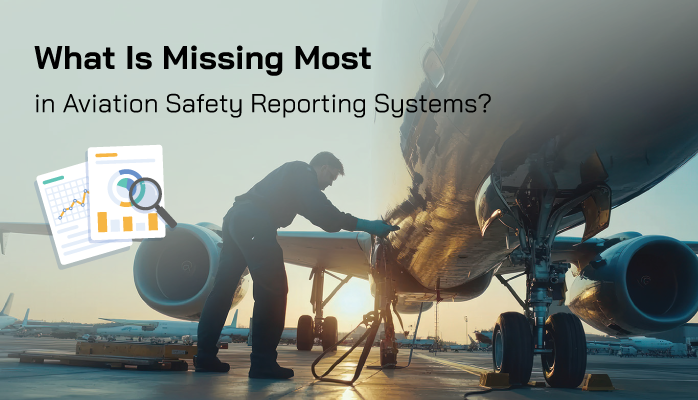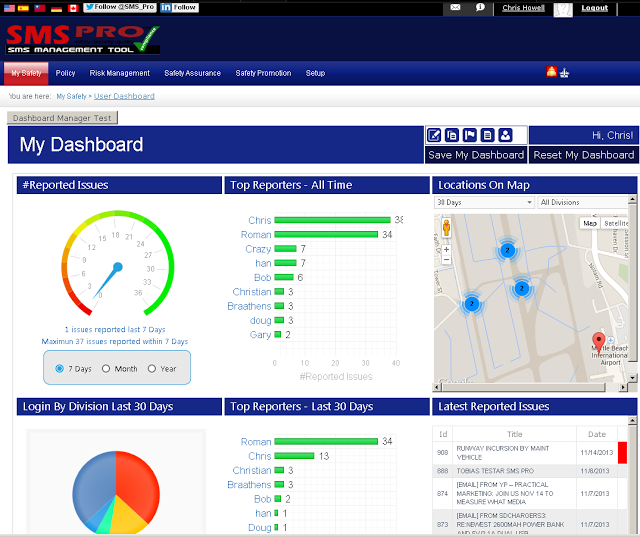Safety Reporting Essential to Aviation Risk Management

Timely reporting of hazards, incidents, or accidents is seen as an essential activity of aviation safety and risk management. I can safely say that without reported hazards or safety issues, there will be:
- little operational improvement and a
- needless waste of resources.
Without an effective hazard/safety reporting culture, there is no way that any aviation service provider can demonstrate continuous improvement to their aviation safety management system (SMS).
Related Articles on Aviation Safety Reporting
- 5 Simple Tips to Improve Aviation Safety Reporting Cultures
- How to Develop Healthy Safety Reporting Cultures in Aviation SMS
- How to Develop a Hazard Reporting System in Aviation SMS [With Free Checklist]
Aviation safety professionals know continuous improvement of the SMS is the third element of "safety assurance," which is a required and demonstrable activity in an ICAO compliant aviation SMS.
Hazard and safety reports are necessary. If you want a quick win and don't want to read further, see some best practices for hazard identification.
Otherwise, you may be interested in learning what are the essential components of an aviation safety reporting system that allows stakeholders to report safety concerns, including hazards that may manifest themselves into "The Accident" that we all fear, but don't know when and where it will occur.
Cultivating Employees to Reduce Risk
Reported data from hazard and incident reports support safety risk assessments and risk mitigation strategies. The best source of raw safety data is direct reporting by front-line personnel. Front-line employees are naturally positioned to observe hazards as part of their daily activities.
Companies with healthy safety cultures have trained personnel that are constantly encouraged to reactively and proactively report
- Errors;
- Identified hazards;
- Operational quality concerns;
- Close-calls (incidents); and
- Accidents.
A safety reporting system allows aviation service providers to collect occurrence data and manage associated risk using established risk management processes. Hopefully, the risk management processes are documented in your SMS manual, otherwise, you will be like hundreds of other operators and get an audit finding based on not following the procedures outlined in the SMS manual. This is the most common audit finding I've seen in the past dozen years.
Related Articles on Aviation SMS Manuals
- How to Create Your Aviation SMS Manual
- Tips Writing SMS Manuals With Aviation Safety Database Solutions
- 3 Best Practices for Your Aviation SMS Manual
Components of Hazard/Safety Reporting Systems
Most of us can intuitively conceptualize what makes up a safety reporting system; however, most will stop short and not realize the complete picture. To properly understand what is an aviation safety reporting system, it is better to break down the individual components of this system.
These components include:
- Hazard reporting forms (or a way for reports to enter a "system");
- Hazard identification training (let employees understand hazards and risks and controls);
- Risk management processes;
- Documentation of risk management activities; and
- Reports (graphics or tabular).
If I were not an aviation safety professional, my mind would have stopped at the first point. Would you have thought this out to completion?

Each of these components is typically tailored for a different "end-user" group. For example, users reporting hazards, accidents or incidents may include:
- Employees;
- Customers;
- Contractors;
- Vendors; and
- Suppliers.
User groups interfacing with risk management processes include:
- Safety managers;
- Safety committees;
- SMS consultants;
- Department heads;
- Executives; and
- Auditors.
Finally, graphical reports allow managers to make informed decisions and introduce change. However, the most important information gleaned from these reports will be SMS performance monitoring data that must be regularly reviewed by the accountable executives.
Monitoring the performance of the SMS is critical for accountable executives to monitor their responsibilities to the SMS and to address any identified shortcomings.
Related Articles on SMS Performance Monitoring
- 4 Pillars | How to Conduct Safety Performance Monitoring and Measurement
- My Safety Score - What's Yours? Aviation SMS Performance Monitoring
- 5 Useful Safety Performance Monitoring Tools in Aviation SMS
Most Common Element Missed in SMS Safety Reporting Systems
The logical mind will say, that is great, Chris.
- We have reporting tools.
- We have tools to manage the reported safety concerns.
- And we have charts and pretty pictures, so management knows where to focus their risk management efforts.
Q: What is missing in most safety reporting systems?
A: Safety promotion tools to constantly encourage those front-line employees to continue reporting. Safety promotion tools close the loop and sustain the safety reporting process.
Safety promotion can take the form of:
- Email responses "thanking" stakeholders for submitting safety reports;
- Safety message board alerting employees of top hazards;
- Hazard identification training;
- Lessons learned library;
- Safety posters around the workplace;
- Regular safety newsletters;
- Safety surveys;
- Safety meetings; or
- Identification badges with the URL to your hazard reporting system.
Final Thoughts on Aviation Safety Reporting Systems

Healthy safety reporting cultures are among the biggest challenges faced by aviation service providers around the world. Oddly enough, safety culture is not a requirement from any of the civil aviation authorities, but safety culture can be measured.
I can look at any aviation SMS and immediately tell what sort of safety culture is present.
How many safety reports are in the system?
What types of safety reports?
What percentage of safety reports are:
- Accidents;
- Incidents;
- Potentially unsafe conditions; and
- Close calls.
How many close calls are reported in your company compared to reported safety concerns that actually caused damage?
Most aviation service providers remain in the reactive risk management mode when a small percentage are actively engaged in proactive risk management. Of course, getting the real benefits from predictive risk management processes continues to elude the majority of aviation service providers because they still don't have adequate SMS data management strategies.
I see this daily because I monitor hundreds of SMS databases.
Chances are that your company needs help with a consistent, effective safety promotion program. Or you may lack an easy way for employees to submit safety concerns.
Do you think I missed anything?
Related Articles on Aviation Risk Management
- What Is Reactive Risk Management (Why It’s Essential for Aviation SMS)
- Going From Reactive to Predictive Risk Management in Aviation SMS
- How to Practice Reactive, Proactive, and Predictive Risk Management in Your
Efficient data management continues to be the number one reason aviation service providers are unable to maximize the benefits of aviation SMS implementations. To see the components of an aviation safety reporting system in action, request a live demo. I'll share my desktop with you and your team for an interactive discussion.
First, watch these short demo videos in order to prepare yourself to ask the "right questions."
Live SMS Pro Demo
After watching the videos, does it look like we are a good fit? Have questions? Sign up for a live demo.
Last updated March 2025.







